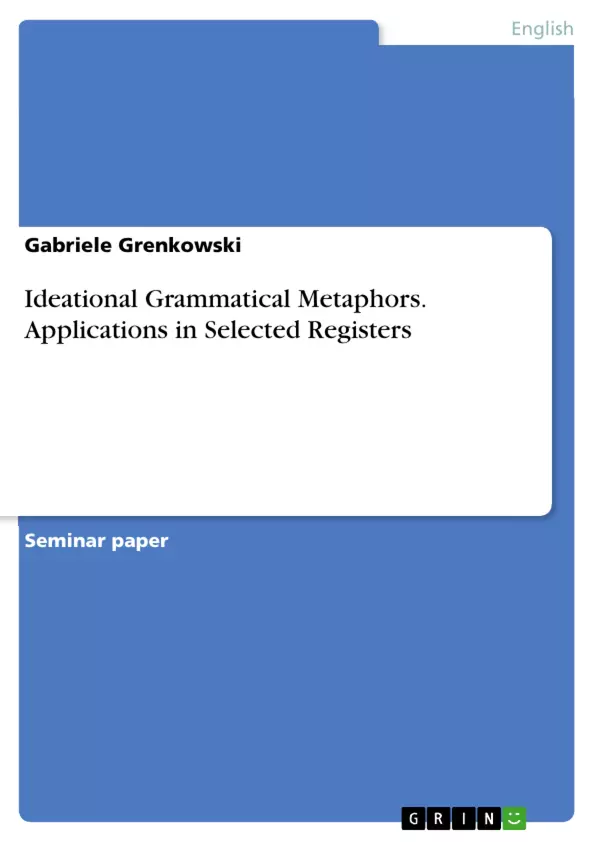This term paper deals with the topic of grammatical metaphors, with a special focus on grammatical metaphors of the ideational kind and their use in certain registers.
To define grammatical metaphor, as well as explain and analyze their use, I will take a closer look at the works of several researchers and linguists, with M.A.K. Halliday being the most important one of these. Given it was Halliday who first coined the term “grammatical metaphor” and tried to give a detailed explanation of the concept, his works will be the most vital to this paper and stand at its center.
Further, it is impossible to take a detailed look on grammatical metaphor without having at least a basic understanding on Halliday’s concept of Systemic Functional Linguistics (SFL). Therefore, one chapter of this paper will take a closer look at SFL and basically explain this concept.
The questions this paper is supposed to answer are the following: what are ideational grammatical metaphors, in which registers are they used most frequently, and what is the purpose or function of such metaphors in these registers?
Inhaltsverzeichnis (Table of Contents)
- Introduction
- Systemic Functional Linguistics
- Grammatical Metaphor
- Types of Grammatical Metaphors
- Ideational Grammatical Metaphors
- Interpersonal Grammatical Metaphors
- Types of Grammatical Metaphors
- Halliday's Transitivity System
- Nominalization
- Grammatical Metaphor
- Uses of Ideational Grammatical Metaphor in Certain Registers
- Ideational Grammatical Metaphor in Scientific Texts
- Objectivity
- Condensation
- Higher information density/lexical density
- Technicality and Rationality
- Examples
- Ideational Grammatical Metaphor in Political Speech
- The speeches of George W. Bush
- The speeches of Barrack Obama
- Functions of IGM in Political Texts
- Ideational Grammatical Metaphor in Scientific Texts
Zielsetzung und Themenschwerpunkte (Objectives and Key Themes)
This paper aims to explore the concept of grammatical metaphors, specifically those of the ideational kind, and their application in different registers. It will delve into the work of various researchers, particularly M.A.K. Halliday, who first coined the term "grammatical metaphor" and provided a comprehensive explanation. The paper will also examine the relationship between grammatical metaphor and Halliday's concept of Systemic Functional Linguistics (SFL). Through this analysis, the paper seeks to answer these questions: what are ideational grammatical metaphors, in which registers are they most prevalent, and what purpose do they serve in those registers?
- Grammatical metaphors and their types
- Ideational grammatical metaphors and their functions
- The role of Systemic Functional Linguistics (SFL) in understanding grammatical metaphors
- Application of ideational grammatical metaphors in scientific texts and political speech
- The impact of ideational grammatical metaphors on the meaning and structure of language in specific registers
Zusammenfassung der Kapitel (Chapter Summaries)
The introduction sets the stage for the paper, outlining the focus on ideational grammatical metaphors and their use in specific registers. It highlights the significance of M.A.K. Halliday's contributions to the field. The chapter on Systemic Functional Linguistics (SFL) introduces Halliday's approach to language, emphasizing its focus on the functions of language rather than its structure. It explores Halliday's concept of "grammatical metaphor" and differentiates it from "normal" metaphor, emphasizing the concept of congruence and its relation to the expression of meaning.
The chapter on ideational grammatical metaphors in scientific texts examines the role of objectivity, condensation, information density, technicality, and rationality in scientific writing. It explores how ideational grammatical metaphors contribute to the concise and precise nature of scientific language. The chapter on ideational grammatical metaphors in political speech analyzes the speeches of George W. Bush and Barrack Obama, exploring how these metaphors shape the rhetoric and persuasive strategies of politicians.
Schlüsselwörter (Keywords)
This paper examines the concept of grammatical metaphors, specifically those of the ideational kind, as described by M.A.K. Halliday. It explores their application in various registers, particularly scientific texts and political speech, highlighting the functions of these metaphors in shaping meaning and structure within these contexts. Key themes include Systemic Functional Linguistics (SFL), transitivity system, nominalization, objectivity, condensation, information density, technicality, rationality, and persuasive rhetoric.
- Citar trabajo
- Gabriele Grenkowski (Autor), 2015, Ideational Grammatical Metaphors. Applications in Selected Registers, Múnich, GRIN Verlag, https://www.grin.com/document/318657



